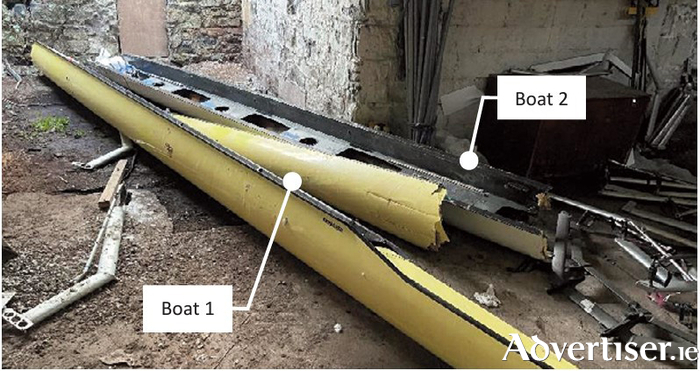Major gaps in safety cover for the city’s fast-flowing water courses have been highlighted by a damning report into an incident where two racing boats were lost on the River Corrib last year.
The Marine Casualty Investigation Board (MCIB ) has published a 140-page report into the events of 14 January, 2023, when at least ten people fell in to the water, some of whom were swept toward the Salmon Weir.
The Board has advised “that a repeat incident is likely if action is not taken to change the current situation”. This stark warning refers to the 1980s-era floating safety boom which did prevent boats and casualties being swept downstream. Its outmoded design – installed at right angles to the river’s flow - makes it difficult for rescuers to recover people clinging to it.
Two competitive shells were lost during the scheduled winter training session on a day when winds reached near gale-force. The MCIB described the event as posing “a threat of death or serious injury”.
The report notes that many of the water users involved were novices, and were not wearing lifejackets as competitive oarsmen are exempted from relevant legislation mandating personal floatation devices.
Local rowing clubs on the Corrib did undertake a major review of their practices in 2017, and there has been a massive emphasis on water safety since then.
One senior club official described the MCIB report as a “curate’s egg,” in that it includes criticism and approval.
The Board has recommended to progress plans to locate a lightweight, D-Class rigid inflatable rescue boat (RIB ) upstream of the weir, to be operated by Galway Fire & Rescue Service. Woodquay is understood to be the preferred location on the eastern bank, followed by University of Galway lands on the west side.
At present, the closest rescue vessel upstream of the weir is the Corrib-Mask Search and Rescue boat stationed in Lisloughrey, Co Mayo. This volunteer unit is 42km from the Salmon Weir - approximately one hour away.
Downstream, the RNLI’s larger B-Class RIB is based near Galway Docks. It can provide rescue and recovery of persons who have already been carried by the river, down through the city. This fast boat cannot pass under Wolfe Tone Bridge, or access Lough Atalia.
One of the most dangerous sections of the River Corrib, known as the Queen’s Gap or Main Gap, is close to the new pedestrian bridge, Droichead an Dóchais. Disused eel and fish traps, known locally as ‘the Cribs’, pose serious entanglement risks to rescuers. This stretch is deemed ‘out of bounds’ for emergency services. Last summer, a body could not be retrieved there for three weeks due to dangers posed to personnel, and there are reports of 12-hour efforts to retrieve live casualties.
Arthur Carr is a founder member of Claddagh Watch, the riverside volunteer patrol. He says designers of new structures, such as Droichead an Dóchais, and the proposed cycle bridge to sit on the old railway stacks only yards away from the Salmon Weir safety boom, should liaise with a multi-agency group, including the main emergency services, which meets quarterly to discuss Corrib River safety.
“The fire service and the RNLI volunteers have been saving lives on our river for years,” he says. “They are the ones who will have to work on, from and below these new structures, so really the designers should be inviting all of us in to talk about how to make them safe.”

